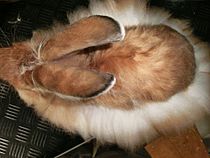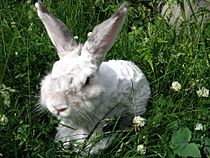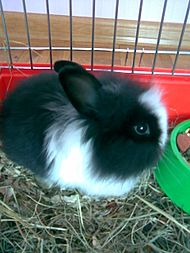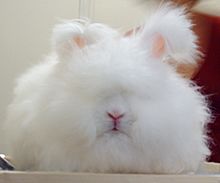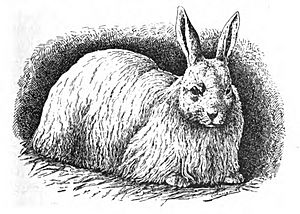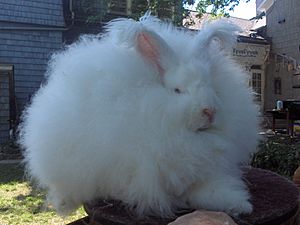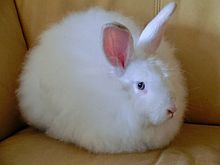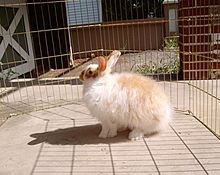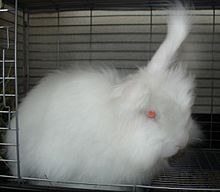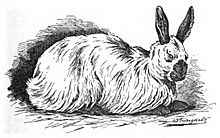Angora rabbit facts for kids
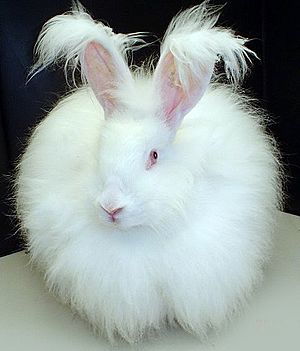 |
|
| Country of origin | |
|---|---|
| Distribution | Worldwide |
| Type | English, French, German, Giant, Satin, Chinese, Finnish, Japanese, Korean, Russian, St. Lucian, Swiss |
| Use | Angora wool production, pet |
| Traits | |
| Weight |
|
| Coat | Long, Fine |
| Wool color | White or Colored Natural or Dyed |
| Color | Albino ("Ruby-eyed White") or Colored |
| Litter size | 2–12 |
| Lifespan | 7–12 years |
| Notes | |
| Coat can require weekly-regular grooming | |
The Angora rabbit (Turkish: Ankara tavşanı) is one of the oldest types of domestic rabbit. People raise them for their very long, soft fur, called Angora wool. This special wool is collected by shearing (cutting), combing, or plucking (gently pulling out loose hairs).
Angora rabbit wool is a great choice for people with allergies to other animal furs. There are at least 11 different kinds of Angora rabbits. Four of these are officially recognized in the United States by the American Rabbit Breeders Association (ARBA). These are the English Angora, French Angora, Giant Angora, and Satin Angora. Other types include the German, Chinese, Finnish, Japanese, Korean, Russian, St. Lucian, and Swiss Angora rabbits.
Contents
History of Angora Rabbits
The Angora rabbit is believed to have come from Ankara, a city in modern-day Turkey. This city was once known as Angora. These rabbits were first brought to France in 1723.
By the mid-1700s, Angora rabbits became popular pets for French royalty. By the end of that century, they had spread to other parts of Europe. In the United States, clothes made from Angora wool became popular in the early 1900s. During World War II, the demand for Angora wool grew a lot. People loved this soft, silky fiber and the process of making it.
All About Angora Wool

Angora rabbits are mostly raised for their wool, which is very silky and soft. It is super fine, about 14–16 microns thick. This makes it similar to cashmere in how soft it feels. A healthy adult Angora's wool can grow about 3 centimetres (1.2 in) every month.
It is very important to groom Angora rabbits regularly. This stops their fur from getting tangled and matted. Matted fur can be uncomfortable and even painful for the rabbit. It can also lead to infections. Angora wool is collected every three to four months throughout the year. After about six months of growth, the wool can start to "die" and get matted easily.
Angora wool can be collected by gently pulling out hairs that are naturally shedding. For a full harvest, the rabbit's coat is shorn (cut) with clippers or small scissors. This is often done while the rabbit sits on a special grooming table. Shearing usually starts at the head and moves towards the tail. Then, the rabbit is turned over, and the underside is shorn from tail to chin. A Giant Angora rabbit can produce between 12 ounces (340 g) and 18 ounces (510 g) of wool.
Rabbit Health Concerns
Wool Block
Angora rabbits have very long and thick hair. This makes them prone to a serious problem called wool block. This happens when a blockage forms in their digestive system. All rabbits swallow some fur when they groom themselves. However, their bodies cannot digest this foreign material. The long hairs of Angora rabbits make this risk even higher. A severe blockage can be deadly. To prevent wool block, it is important to clip or pluck an Angora's wool every 90–120 days.
Wool Mites
Cheyletiella parasitovorax is a tiny skin bug that often lives on Angora rabbits. If a rabbit has wool mites, you might see flaky skin patches and fur loss. These mites reduce the amount of wool a rabbit produces. The skin flakes also make the wool quality worse. Wool mites can be treated with special medicines like ivermectin or carbaryl powder.
Types of Angora Rabbits
The famous long coat of the Angora rabbit comes from a special rabbit gene called l (lowercase "L"). This "Angora gene" is found in all Angora breeds. Sometimes, this gene has been used to create other rabbit breeds or new types of existing breeds. In the U.S., "Dwarf Wooly" breeds like the American Fuzzy Lop, Lion Head, and Jersey Woolie are now recognized. Belgium and France also have their own Dwarf Wooly breeds. There is also a rare Mini English Angora breed in New Zealand.
English Angora
- Weight: 2.0–3.5 kg (4.4–7.7 lb).
- ARBA-recognized colors: Agouti, Broken, Pointed White, Ruby-eyed White, Self, and Shaded.
Before 1939, there was only one type of "Angora Wooler." In 1939, the ARBA divided them into English Type and French Type. In 1944, they officially became two separate breeds: English Angora and French Angora.
English Angora rabbits have woolly fur on their ears, face (except above the nose), and front feet. They also have a very thick body coat. They are gentle pets, but they need a lot of grooming. Their wool is very thick and needs to be brushed twice a week.
This is the smallest of the four Angora breeds recognized by ARBA. Many people keep them as pets because their faces look like puppies or teddy bears. If their wool has the right texture, it's fairly easy to care for. But if the wool is too "cottony," it needs a lot more grooming. New spinners might find their wool tricky to work with.
English Angora rabbits can have "broken colors," meaning white with black spots. However, this is not allowed in ARBA shows. When an English Angora is shown, its toenails should be one solid color. Their ear tips might be folded over, and the fur on their face can cover their eyes. The English Angora is the only Angora breed that has fur covering its eyes.
French Angora
- Weight: 3.5–4.5 kg (7.7–9.9 lb).
- ARBA-recognized colors: Agouti, Broken, Pointed White, Self, Shaded, Ticked, and Wide Band.
This breed has a thick undercoat. If the wool texture is correct, it needs less grooming than other Angora breeds. Small tufts of fur on the ears are allowed but not usually preferred by breeders. ARBA recognizes the same colors as the English Angora, plus broken patterns. They are shown as 'white' or 'colored' (broken being a colored type). Like other ARBA-shown rabbits, their toenails should be one solid color.
The French Angora is one of the larger Angora breeds, weighing 7.5 to 10 pounds. It has a body shape that is good for commercial use. Unlike the English, Giant, and German Angoras, the French Angora has a clean (hairless) face and front feet. It only has small tufts of fur on its back legs. The color of a French Angora is determined by the color of its head, feet, and tail, which should all be the same color. This type of Angora fiber has a smooth, silky feel. New spinners might find Angora wool a bit challenging.
The wool is valued for its texture, warmth, light weight, and pure white color. It is used to make sweaters, mittens, baby clothes, and hats.
German Angora
- Weight: 2.5–5.5 kg (5.5–12.1 lb).
- IAGARB-accepted colors: Albino or Colored (but not two-colored).
- Albino Color Group
- Albino
- Self Group
- Black
- Blue (Dilute Black)
- Chocolate (Brown)
- Lilac (Dilute Brown)
- Tortoiseshell Group
- Tortoiseshell
- Blue Tortoiseshell (Dilute Black Tortoiseshell)
- Chocolate Tortoiseshell (Brown Tortoiseshell)
- Lilac Tortoiseshell (Dilute Brown Tortoiseshell)
- Agouti Group
- Agouti (Black Agouti, Chestnut Agouti, Wild Agouti)
- Blue Agouti or Opal (Dilute Black Agouti)
- Chocolate Agouti (Brown Agouti)
- Lilac Agouti or Lynx (Dilute Brown Agouti)
- Wide Band Color Group
- Yellow (Red or Fawn)
- Chinchilla Color Group
- Chinchilla
- Blue Chinchilla or Squirrel (Dilute Black Chinchilla)
- Chocolate Chinchilla (Brown Chinchilla)
- Lilac Chinchilla (Dilute Brown Chinchilla)
Even though it is common, the German Angora is not currently recognized by ARBA. The International Association of German Angora Rabbit Breeders (IAGARB) has its own rules for what a German Angora should look like.
Giant Angora
- Weight: Minimum 5.4 kg (12 lb).
- ARBA-recognized colors: Ruby-eyed White.
The Giant Angora is the biggest of the Angora breeds recognized by ARBA. It was first created to be a good wool producer for farms. These rabbits could live in standard wire cages and eat regular rabbit food.
ARBA did not allow German Angoras to be shown because their body type was too similar to other Angora breeds. So, Louise Walsh from Massachusetts created a new breed. She used German Angoras, French Lops, and Flemish Giants to create a completely different body type. ARBA officially recognized the Giant Angora in 1988. Its coat has three types of wool: soft underwool, awn fluff, and awn hair.
The awn-type wool is only found in the Giant and German Angora breeds. The Giant Angora has fur on its face and ears. Many people confuse German and Giant Angoras, but their body shapes are different.
The only color ARBA currently recognizes for the Giant Angora is the Ruby-eyed White (REW). This color means the rabbit has no pigment, like an albino. The Giant Angora produces more wool than the French, Satin, or English Angoras. The Giant Angora is the only Angora breed that is judged in six different age and weight classes. It should have a commercial body type with a very thick wool coat. The head should be oval, wide at the forehead and a bit narrower at the nose. Giant Angoras should have forehead tufts and cheek fur. The head fur should be noticeable, but males usually have more than females. Their ears should have light fringes and good tassels. The Giant Angora is also the only Angora breed shown only as a ruby-eyed white. A black color of the Giant Angora is being developed, but it is not yet approved by ARBA.
The Giant Angora coat has three types of fibers for its texture. The underwool should be the most common. It should be medium-fine, soft, slightly wavy, and have a gentle shine. New spinners might find Angora wool a bit challenging.
The Awn Fluff has a guard hair tip and is a stronger, wavy wool. The Awn Fluff is found between the underwool and Awn Hair. The Awn Hair, also known as guard hair, is the third type of fiber. The Awn Hair is a strong, straight hair that sticks out above the wool. It must be clearly visible.
The way Giant Angoras are judged is different from the other three breeds because they are a 6-class animal. Junior males and females must be under 6 months old and weigh at least 4 ¾ pounds. Intermediate males and females are 6–8 months old. Senior males and females are 8 months old or older. A senior male must weigh at least 9 ½ pounds. A senior female must weigh at least 10 pounds.
When Giant Angoras are judged, most of the points are given for their wool. This includes how thick, soft, and long it is. Points for "general type" include the body shape, head, ears, eyes, feet, legs, and tail.
Like many other "giant" rabbit breeds, the Giant Angora grows slowly. A female usually takes more than a year to reach her full size and weight. A male can take up to 1.5 years to fully mature.
Satin Angora
- Weight: 3.0–4.5 kg (6.6–9.9 lb).
- ARBA-recognized colors: [Includes eight color groups. The color of a Satin Angora is determined by the uniform pigment on its head, feet, and tail.]
- White Group
- Pointed White (includes Black, Blue, Chocolate, Lilac)
- Blue-Eyed White
- Red-Eyed White
- Broken Group
- Broken
- Colored Group
- Chestnut
- Chocolate Agouti
- Chocolate Chinchilla
- Chinchilla
- Copper
- Lilac Chinchilla
- Lynx
- Opal
- Squirrel
- Self Group
- Black
- Blue
- Chocolate
- Lilac
- Shaded Group
- Pearl
- Black Pearl
- Blue Pearl
- Chocolate Pearl
- Lilac Pearl
- Sable Pearl
- Smoke Pearl
- Sable
- Seal
- Pearl
- Tortoiseshell Group
- Blue Tortoiseshell
- Chocolate Tortoiseshell
- Lilac Tortoiseshell
- Tortoiseshell
- Ticked Color Group
- Blue Steel
- Chocolate Steel
- Lilac Steel
- Steel
- Wide Band Color Group
- Cream
- Fawn
- Red
The Satin Angora was created in the late 1970s by Mrs. Meyer in Canada. She crossed French Angoras with rabbits of the Satin breed. This cross not only gave the new rabbits the shiny coat of the Satin breed, but also brought out true red and copper colors. In all "satinized" coats, the hair shaft has a clear outer layer. This layer reflects light, giving the fur a deep color, high shine, and a very soft, silky feel.
The Satin Angora, like the French Angora, does not have fur on its face, ears, or feet. Satin Angoras do not produce as much wool as other Angora breeds. However, breeders are working to improve this through selective breeding. While it's harder to groom than the Giant or French Angora, the Satin Angora is easier to care for than the English Angora. Because its wool is so soft and has fewer guard hairs, it mats more easily. Daily combing is recommended.
Satin Angora wool is said to be stronger for spinning than other Angora types. However, because it is so slippery, it can be harder to spin into yarn.
Other Angora Rabbit Breeds
- Chinese Angora
- Finnish Angora
- Japanese Angora
- Russian Angora
- St. Lucian Angora
- Swiss Angora
- Dutch Angora
See also
 In Spanish: Conejo de Angora para niños
In Spanish: Conejo de Angora para niños


